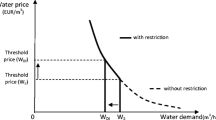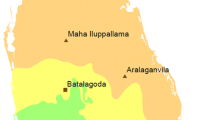Abstract
In many arid countries, rules for the allocation of irrigation water when shortages occur are poorly defined. These weaknesses present a critical constraint to food security and can be a major cause of poverty and hunger. The search for flexible rules for the allocation of irrigation water is especially important in dry regions of the developing world where drought and climate change compound the challenges faced by farmers, extension advisers, water managers and governments. Afghanistan is one country in which inflexible arrangements for allocating irrigation water when drought occurs continue to undermine its food security. This paper develops and applies an empirical framework to evaluate several arrangements for the allocation of irrigation water when shortages occur. The intent of the analysis is to identify a water allocation system for sharing shortages that minimizes the loss in economic benefits and food security by efficiently sharing water supplies when the inevitable drought occurs. An integrated decision framework for water resources is developed that unifies crop, water, and farm data. Several water allocation rules that could increase the flexibility of irrigated agriculture in dealing with water shortages are analyzed for their impacts on farm profitability and food security. Findings show that a proportional sharing of water shortages, in which each canal bears an equal proportion of overall shortages, is the most flexible rule among those analyzed for limiting threats to food security and farm income. This water sharing arrangement is also seen as fair in many cultures and is simple to administer. In the developing world, the design and practical implementation of flexible rules for adapting to periodic water supply changes are important as water shortages become more pronounced in the face of droughts and climate variability. The results provide a framework for identifying, designing, and implementing water allocation rules for food security in the developing world’s irrigated areas.


Similar content being viewed by others
References
Ahmad, M., & Wasiq, M. (2004). Water resource development in Northern Afghanistan and its implications for Amu Darya Basin. Washington, DC: The World Bank.
Asian Development Bank. (2004). Proposed grant assistance for the Islamic Republic of Afghanistan for the Balkh river integrated resources management. Agriculture Environment and Natural Resources Division South Asia Department Japan Fund for Poverty Reduction.
Atwood, D. W. (2005). Big is ugly? How large-scale institutions prevent famines in Western India. World Development, 33(12), 2067–2083.
Batchelor, C. (1999). Improving water use efficiency as part of integrated catchment management. Agricultural Water Management, 40(2–3), 249–263.
Beck, R. (2010). Bi-weekly report, Afghanistan water, agriculture, and technology transfer (Awatt). Report on the Second Mirabs Conference - Central Afghanistan, January 7.
Beck, R. (2010). Quarterly report Fy2010, Jan - March 2010, Afghanistan water, agriculture, and technology transfer. Mirab Conference, January 8.
Biswas, A. K. (2004). Integrated water resources management: a reassessment - a water forum contribution. Water International, 29(2), 248–256.
Castelletti, A., & Soncini-Sessa, R. (2006). A procedural approach to strengthening integration and participation in water resource planning. Environmental Modelling & Software, 21(10), 1455–1470.
Central Statistics Organisation. (2008). Statistical year book 2008–2009, http://www.cso.gov.af/.
Chabot, P., & Dorosh, P. A. (2007). Wheat markets, food aid and food security. Food Policy, 32(3), 334–353.
Dagnino, M., & Ward, F. A. (2012). Economics of Agricultural Water Conservation: Empirical Analysis and Policy Implications. International Journal of Water Resources Development, 28(4), 577–600.
Davis, M. D. (2007). Integrated water resource management and water sharing. Journal of Water Resources Planning and Management-ASCE, 133(5), 427–445.
Eberle, P., Hadley, B., Hawkes, G., Crawford, T., & McDonald, T. (2009). Enterprise budgets for Balkhab watershed Afghanistan: An A.W.A.T.T. decision tool component. Afghanistan: USAID.
Fang, C. L., Bao, C., & Huang, J. C. (2007). Management implications to water resources constraint force on socio-economic system in rapid urbanization: a case study of the Hexi Corridor, Nw China. Water Resources Management, 21(9), 1613–1633.
FAO Information System on Water and Agriculture. (2010). Afghanistan, January 27. http://www.fao.org/nr/water/aquastat/countries/afghanistan/index.stm.
Fisher, F. M., et al. (2005). Liquid assets: An economic approach for water management and conflict resolution in the Middle East and beyond. Washington, DC: Resources for the Future.
Food and Agricultural Organization. (2006). Modern water rights: Theory and practice. Rome.
Gupta, H., & van der Zaag, P. (2008). Interbasin water transfers and integrated water resources management: where engineering, science, and politics interlock. Physics and Chemistry of the Earth, 33(1), 28–40.
Harou, J. J., Pulido-Velazquez, M., Rosenberg, D. E., Medellin-Azuara, J., Lund, J. R., & Howitt, R. E. (2009). Hydro-economic models: concepts, design, applications, and future prospects. Journal of Hydrology, 375(3–4), 627–643.
Huang, Q. Q., Rozelle, S., Wang, J. X., & Huang, J. K. (2009). Water management institutional reform: a representative look at Northern China. Agricultural Water Management, 96(2), 215–225.
Huang, Q. Q., Wang, J. X., Easter, K. W., & Rozelle, S. (2010). Empirical assessment of water management institutions in Northern China. Agricultural Water Management, 98(2), 361–369.
Jewitt, G. (2002). Can integrated water resources management sustain the provision of ecosystem goods and services? Physics and Chemistry of the Earth, 27(11–22), 887–895.
Kugbei, S., & Shahab, S. (2007). Analysis of the seed market in Afghanistan. Food and Agriculture Organization of the United Nations.
Lamberts, D. (2006). The Tonle Sap Lake as a productive ecosystem. International Journal of Water Resources Development, 22(3), 481–495.
Lankford, B., & Hepworth, N. (2010). The Cathedral and the Bazaar: monocentric and polycentric river basin management. Water Alternatives, 3(1), 82–101.
Lankford, B., van Koppen, B., Franks, T., & Mahoo, H. (2004). Entrenched views or insufficient science? Contested causes and solutions of water allocation; Insights from the Great Ruaha River Basin, Tanzania. Agricultural Water Management, 69(2), 135–153.
Lautze, S., Stites, E., Nojumi, N., Najimi, F., & Pool, Q. E. (2002). A cash famine: Food insecurity in Afghaninstan 1999–2002. Feinstein International Famine Center.
Lee, J. L. (2006). Water management, livestock and the opium economy: Social water management. Kabul: Afghanistan Research and Evaluation Unit.
Li, X. Y., Waddington, S. R., Dixon, J., Joshi, A. K., & de Vicente, M. C. (2011). The relative importance of drought and other water-related constraints for major food crops in South Asian farming systems. Food Security, 3(1), 19–33.
Mahmoodi, S. (2008). Integrated water resources management for rural development and environmental protection in Afghanistan. Journal of Developments in Sustainable Agriculture, 3(1), 9–19.
Mainuddin, M., Kirby, M., & Hoanh, C. T. (2011). Adaptation to climate change for food security in the Lower Mekong Basin. Food Security, 3(4), 433–450.
Maletta, H. (2004). The grain and the chaff, crop residues and the cost of production of wheat in Afghanistan. Universidad Del Salvador (July).
Maletta, H. (2006). Cereal self-sufficiency in Afghanistan farms. Universidad Del Salvador (April).
Maletta, H. (2007). Arable land tenure in Afghanistan in the early Post-Taliban Era. African and Asian Studies, 6, 13–52.
Maletta, H., & Favre, R. (2003). Agriculture and food production in post-war Afghanistan: A report on the winter agricultural survey. Kabul: Afghanistan Ministry of Agriculture and Animal Husbandry.
McCormick, Z. L. (1994). Interstate water allocation compacts in the Western United States - some suggestions. Journal of the American Water Resources Association, 30(3), 385–395.
Ministry for Rural Rehabilitation and Development of Afghanistan. (2007). Balkh provincial profile. National Area-Based Development Program (NABDP).
Mu, J. X., & Khan, S. (2009). The effect of climate change on the water and food Nexus in China. Food Security, 1(4), 413–430.
Mulwafu, W. O., & Msosa, H. K. (2005). Iwrm and poverty reduction in Malawi: a socio-economic analysis. Physics and Chemistry of the Earth, 30(11–16), 961–967.
Murad, A. A., Al Nuaimi, H., & Al Hammadi, M. (2007). Comprehensive assessment of water resources in the United Arab Emirates (Uae). Water Resources Management, 21(9), 1449–1463.
Namara, R. E., Hanjra, M. A., Castillo, G. E., Ravnborg, H. M., Smith, L., & Van Koppen, B. (2010). Agricultural water management and poverty linkages. Agricultural Water Management, 97(4), 520–527.
Natsios, A. S. (2005). The nine principles of reconstruction and development. Parameters, 10(Fall), 4–20.
Pauli, P. (2008). National risk and vulnerability assessment 2007/8: A profile of Afghanistan, January 17. http://nrva.cso.gov.af/NRVA%202007-08%20Report.pdf.
Pigram, J. J. (2001). Water resources development, opportunities and constraints in the transfer of water technology and experience between countries and regions. International Journal of Water Resources Development, 17(4), 563–579.
Qureshi, A. S. (2002). Water resources management in Afghanistan: The issues and options, Pakistan country series no. 14 (p. 24). Columbo: International Water Resources Management Institute.
Rout, B. (2008). Water management, livestock and the opium economy, how the water flows, a typology of irrigation systems in Afghanistan. Afghanistan Research and Evaluation Unit.
Scott, C. A., El-Naser, H., Hagan, R. E., & Hijazi, A. (2003). Facing water scarcity in Jordan - reuse, demand reduction, energy, and transboundary approaches to assure future water supplies. Water International, 28(2), 209–216.
Shobair, S. S. (2001). Current drought situation in Afghanistan, drought assessment and mitigation in Southwest Asia. International Water Management Institute.
Shobair, S. S., & Alim, A. K. (2004). The effects of calamities on water resources and consumption in Afghanistan. FAO UN.
Svendsen, M., Wester, P., & Molle, F. (2005). Managing river basins: An institutional perspective. In M. Svendsen (Ed.), Irrigation and river basin management, options for governance and institutions. Columbo: International Water Management Institute.
Thomas, V., & Ahmad, M. (2009). A historical perspective on the Mirab System: A case study of the Jangharoq Canal, Baghlan, Afghanistan Research and Evaluation Unit Case Study Series, Kabul, Afghanistan. http://www.areu.org.af/EditionDetails.aspx?EditionId=214&ContentId=7&ParentId=7.
Turral, H., Svendsen, M., & Faures, J. M. (2010). Investing in irrigation: reviewing the past and looking to the future. Agricultural Water Management, 97(4), 551–560.
United Nations. (2009). Afghanistan humanitarian action plan 2010, January 17. http://ochaonline.un.org/humanitarianappeal/webpage.asp?Page=1832.
United States Agency for International Development. (2007). The contribution of regional markets to Afghan Wheat Supplies. Famine Early Warning Systems Network.
van der Zaag, P. (2005). Integrated water resources management: relevant concept or irrelevant buzzword? A capacity building and research agenda for Southern Africa. Physics and Chemistry of the Earth, 30(11–16), 867–871.
Waddington, S. R., Li, X. Y., Dixon, J., Hyman, G., & de Vicente, M. C. (2010). Getting the focus right: production constraints for six major food crops in Asian and African farming systems. Food Security, 2(1), 27–48.
Yang, H., Zhang, X. H., & Zehnder, A. J. B. (2003). Water scarcity, pricing mechanism and institutional reform in Northern China irrigated agriculture. Agricultural Water Management, 61(2), 143–161.
Yates, D., Sieber, J., Purkey, D., & Huber-Lee, A. (2005). Weap21 - a demand-, priority-, and preference-driven water planning model part 1: model characteristics. Water International, 30(4), 487–500.
Zaheer, F. (2009). Layout of Balkh River Basin canal system. Personal Communication, edited, Personal Contact.
Ziaee, F. (2011). Drought vulnerability and adaptation in Balkh Province of Afghanistan MSc thesis, Delft, The Netherlands.
Author information
Authors and Affiliations
Corresponding author
Additional information
Support by these organizations is gratefully acknowledged:
• New Mexico Agricultural Experiment Station
• US Geological Survey
• UNESCO-IHE Institute for Water Education, the Netherlands
Rights and permissions
About this article
Cite this article
Ward, F.A., Amer, S.A. & Ziaee, F. Water allocation rules in Afghanistan for improved food security. Food Sec. 5, 35–53 (2013). https://doi.org/10.1007/s12571-012-0224-x
Received:
Accepted:
Published:
Issue Date:
DOI: https://doi.org/10.1007/s12571-012-0224-x




